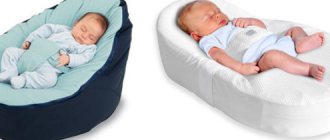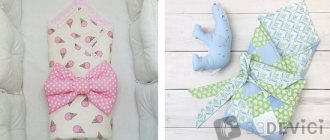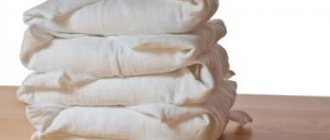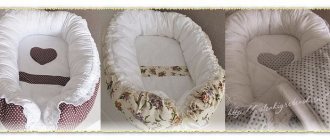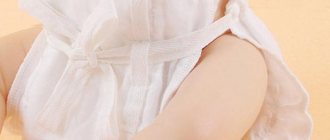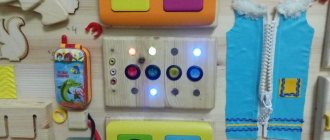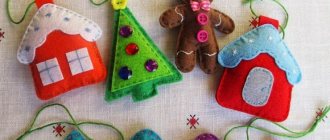Every year, more and more different inventions are invented for new mothers, aimed at simplifying the care of a small child. One of these ideas that has found grateful fans is a cocoon for newborns. Tight swaddling is now sharply criticized, so this way of creating comfort for the baby is the best solution for modern parents. Today we will tell you in some detail about how to make a cocoon for a newborn with your own hands.
Every resident and guest of St. Petersburg can undergo a full examination of the body at the medical center. You can find out more on the website: https://benefacta.ru/services/polnoe_obsledovanie_organizma/
Most popular questions
How can you decorate a cocoon?
In order for the finished product to have a finished look, it must be decorated using various aesthetic elements not only for decoration, but also to disguise poorly executed areas. When choosing such little things that are pleasant to the heart, you should be guided by the gender of the child, the material used to sew the mattress, as well as individual preferences.
For example, when it comes to a cocoon for a girl, thin natural lace, satin elements, braid, rhinestones, artificial pearls on a flat base, embroidered appliqués and other decorative elements are used.
For boys, thin twines for tightening the drawstrings and print transfers in a marine theme, which can be transferred to the fabric using an iron and damp gauze, are suitable.
The cocoon can be easily turned out and used on both sides
Cocoons in the patchwork style will also look great, for the production of which you need to sew many colorful patches into a single fabric. Also, recently, nests made of very thick natural wool, which is knitted with the thickest knitting needles, are becoming increasingly common.
What are the pros and cons of sewing yourself? Sewing any product yourself has its pros and cons. The first include the possibility of producing an exclusive model to suit your taste and budget, saving money when receiving a handmade product, as well as complete confidence in its high quality.
Unfortunately, there are serious shortcomings, the most important of which is the risk that the finished result will not live up to expectations. Among other things, even the simplest cocoon requires a lot of effort and time, which not every mother has.
However, all the disadvantages pale in comparison to the love and care that a mother puts into making a nest for her beloved child, who will definitely feel the warmth of the hands of the person closest to her.
How to sew a cocoon for a newborn with a zipper
Diapers with a zipper are a very convenient and necessary accessory. This diaper helps to swaddle a baby in a couple of seconds. In this case, the baby will definitely not get out of the cocoon, since he will hardly be able to unfasten the zipper.
Ideally, it would be possible to take measurements of the baby so that the zippered diaper fits. It must be remembered that its purpose is to create the illusion of a protected space in the child, and not to tightly fetter movements. The size must be selected in such a way that the baby can move his arms and legs, and the blood flow is not disturbed.
These products are sewn from soft cotton fabric, for example, a cooler
To sew a diaper, you will need the following materials:
- Knitted cotton fabric – 1 meter.
- Zipper – 1 pc.
- Threads of a suitable color.
- Paper for drawing a pattern.
- Chalk.
- Scissors.
- Button clasp – 1 pc.
Pattern:
The diaper according to this pattern is suitable for a baby from birth to 2-3 months. The pattern is given taking into account seam allowances
- You need to transfer the pattern onto paper in full size and cut it out.
- Then the fabric is folded in half, right side inward. The pattern is transferred to the fabric using chalk. You should end up with two parts.
- The front piece is cut in the middle. The length of the cut should correspond to the length of the purchased fastener.
- In addition, you need to cut out the collar and the placket for the button fastener at the top of the zipper. These details are cut out with simple rectangles. The length of the rectangle for the collar is equal to the circumference of the neck, and the fastener bar is cut out arbitrarily.
- The two main pieces need to be sewn together at the sides, shoulders and bottom.
The edges of the seams must be carefully seamed by hand or processed using an overlocker.
6. Next, the zipper is sewn in.
It is better to baste the zipper first. This will make the seams more even.
7. After this, you need to sew on a collar and a protective strip with a button fastener.
Instead of a button on the protective strip, you can use Velcro
The diaper is ready!
For a warmer option, you can cut out the lining or use fleece as the main fabric. In this case, the diaper is sewn in exactly the same way, only you will need to cut out not two, but four parts of the product (top layer and lining).
Cocoon diaper with zipper
It is customary to swaddle babies to ensure a restful sleep without being scared by the movements of their arms. To facilitate the process, a cocoon diaper with a zipper was invented. It makes the swaddling process easier for new parents. The cocoon-shaped diaper allows the baby freedom of movement.
Features of the cocoon diaper
In the modern world, they believe that there is no need to swaddle children tightly. This type of diaper leaves the baby freedom, only slightly limiting it. Does not require special swaddling skills from parents.
The shape of the cocoon gives the baby a feeling of security, like in the mother's belly. This helps the baby adapt to the new environment. The cocoon diaper for newborns with a zipper is sewn from cotton jersey. It does not cause allergic reactions and fits well to the skin and does not restrict movement. The design is incredibly convenient and compact.
If we consider which is better, a knitted diaper or a cocoon diaper, then the second one wins in many respects. Sewn like a cocoon, it has no internal seams and will not rub the baby’s delicate skin.
The cocoon diaper with a zipper is not suitable for premature babies.
When choosing a cocoon diaper, pay attention to its size and the quality of the material from which it is made. The neck should be wide so as not to put pressure on the neck. Keep this in mind if your baby is large. Buy them in specialized stores to avoid low-quality goods. A low price may indicate poor quality, uneven seams, or unnatural materials.
Pattern of a euro cocoon diaper with a zipper
The usual diaper has been replaced by an incredibly comfortable euro diaper, similar to a bag with a lock. It provides comfort for the baby, in which he remains in the fetal position to which he is accustomed.
It is easy to sew this type of diaper with your own hands. The pattern is very simple, so any mom can handle the sewing, even if she has no sewing skills.
Choice of fabric. First, we select the fabric, it should be natural and stretch well. You will need a cut about 120 cm long and 150 cm wide. The pattern of a cocoon diaper with a zipper is made first on paper, and only then transferred to fabric. Allow seam allowances of about 0.5 - 1 cm.
Dimensions. When choosing a size, take into account the child's height. For every 2 centimeters of growth, add 12 cm of canvas. The main condition is that the seams and zippers are made on the outside of the product. This is done so as not to cause irritation to the skin. For stitching we use a zigzag stitch. The time for cutting and sewing a diaper is about one hour.
You just need to put your baby in this diaper and fasten the clasps. The baby's arms can be placed on the sides or so that they are at the chest. He will feel comfortable and calm in it.
How to sew a cocoon diaper with a zipper?
Sewing the product is quite simple. It is much better to make the pattern yourself, since the mother knows the size of her baby.
For sewing you will need:
- a piece of knitted fabric;
- sewn-in lock;
- threads;
- interlining.
Sewing process:
- draw the pattern on tracing paper or a sheet of paper and cut it out;
- Place it on a piece of knitted fabric and draw it out, not forgetting to allow seam allowances. We cut out the back and two shelves from knitwear, and make the lining from cotton. Don't forget that the main fabric needs to be made a little larger than the lining;
- we process the edges of each part with a zigzag or overlock;
- we baste the top with a lining to make sewing easier;
- At the place where the zipper is sewn in, we glue it with non-woven material, stitch the edges and sew in a lock. Non-woven fabric is needed to ensure that the product does not lose its shape over time;
- sew the remaining edges of the parts. We sew the cocoon diaper carefully, slowly, and the result will please you.
Try not to be distracted while sewing to avoid making mistakes. You can sew a cocoon diaper with your own hands, a warmer one with a fleece lining, or by laying padding polyester inside. You can choose any color, or complement it with various applications.
How to swaddle a baby in a cocoon swaddle with a zipper video:
Of course, it’s easy to buy everything you need for a newborn, but a DIY cocoon diaper will not only be convenient and practical, but will also fit perfectly. Made with soul and maternal love, it will delight the baby with warmth and comfort for a long time.
pelenku.ru
How to sew it yourself
The only drawback of Babynest, or, as it is popularly called, a baby nest, is its high cost. Not every mother can afford such expenses, given that the device will not last long. But if you wish, have free time and basic sewing skills, you can sew a nest for a newborn with your own hands. It's not at all difficult to make.
How to sew a nest for newborns with your own hands?
To do this you will need:
2 pieces of fabric measuring 0.8x1 m. The colors of the cuts may be different, then you can sew a double-sided nest for newborns. 2.6 m lace. About 3 m of satin ribbon. 1 kg of holofiber or synthetic fluff for the bottom and sides. The mattress in the nest for newborns can be padded with padding polyester in several layers
It is important that the bottom is soft. Matching thread colors.
To make a nest for newborns, you will need a pattern.
You can watch the video at the end of the article, which shows a step-by-step master class on making a nest for a newborn.
To sew the device, you need to do the following:
- Transfer the pattern of the nest for a newborn, which you decided to make with your own hands, onto the fabric, taking into account the seam allowances. When transferring a nest pattern for newborns, you need to mark the middle and seam line. If the product is in one color, then the fabric should be folded in half when cutting. If you want to sew a nest for newborns with your own hands in different colors, you need to cut out two identical parts from different fabrics using a pattern.
- Baste the resulting parts with the right side inward along with the lace. After this, sew the seams and overcast the edges.
- Turn the resulting workpiece inside out and iron it carefully.
- Sew the place for the ribbon, leaving 2 cm from the edge.
- Next you need to make a mattress into a nest for newborns. To make the nest comfortable for the baby, it is recommended to make several bottom parts from padding polyester or holofiber according to the pattern and fill the fabric blank with them. The mattress must be soft. To prevent padding polyester or holofiber from pilling or bunching up when washing, you can make several transverse or oblique seams along the bottom.
- Using a pin, thread the ribbon through.
- Fill the sides with holofiber.
- Carefully sew open edges by hand. It is advisable to use a hidden seam.
- Pull the edges of the ribbon and tie a bow. The tape does not need to be cut short, so that in the future it will be possible to adjust the size of the nest as the child grows. It is advisable to process the edges of the tape so that they do not crumble.
A homemade nest for a newborn has many advantages over a finished product. Firstly, it will be made with mother’s love and warm thoughts about the baby. Secondly, mom can choose the color of the fabric and ribbon to her taste and control the quality of the materials.
It is important that you can make a nest for newborns with your own hands according to an individual pattern for any size. The cost of a product made independently is several times lower than the price that you will have to pay in a store for a finished item.
Therefore, if you want to get a high-quality, inexpensive and individually sized nest for newborns, then the mother has no choice but to sew it herself or order it individually from a craftsman.
DIY Velcro diaper: pattern and master class
More recently, baby diapers with Velcro have appeared and become extremely popular. Sewing these Velcro diapers for newborns with your own hands is not difficult.
What types of Velcro diapers are there for newborns?
Nowadays, there is a large selection of diapers on sale from a variety of fabrics and at different prices.
Types of Velcro diapers:
Knitted diapers with Velcro. Made from natural fabrics. Create maximum comfort, taking the shape of the newborn's body.
Fleece diaper with Velcro. Suitable for walks in the off-season. Warm and soft.
Velcro diaper Matryoshka (Butterfly). The Butterfly or Matryoshka diaper deserves its name due to its wide top shape. The child can feel himself with his hands and explore. Thanks to Velcro, mom can adjust the free space inside the diaper.
Diaper envelope for sleeping with Velcro. The product can be either cotton or insulated. The Velcro diaper envelope allows the baby to turn freely on its side, while the product does not move out, there are no folds under the back. This is very important when walking in cold weather.
The Velcro cocoon diaper comes in standard and extended versions. Made from natural fabrics, most often cotton. The product can be adjusted in length, which is very practical to use.
Star Velcro diaper. The excellent and convenient design of the product gives not only comfort to the baby, but also a good mood to the mother.
No fasteners!
More recently, a modern Velcro diaper has appeared. Sleeping in it is very comfortable, the baby’s body does not press anywhere, there are no folds in the fabric. The child is less capricious, the mother is not so tired. This baby diaper is sewn with Velcro from various materials: cotton and knitwear, flannel and flannel. The product is produced in two sizes - up to three months and from three months to six.
Velcro diaper sizes
First, you need to decide how long you will need to swaddle your baby. A child grows up very quickly, especially in the first year of life. And it is better to buy diapers one size larger, since the baby is trying to get out of them. Most often, square-shaped products are found, but there are also triangular diapers.
The sizes of Velcro diapers for a newborn are the same in most cases, from chintz no more than 90 cm by 120 cm, there are also 85 cm by 90 cm, or 95 cm by 100 cm - these are triangular diapers.
Warm flannel diapers are always larger in size than calico ones, knitted ones - 90 cm by 112 cm, and when the child grows up, they are used already - 110 cm by 120 cm.
Velcro diaper pattern with dimensions
All newborn babies need warmth and comfort, hugs from mom and dad. A Velcro sleep diaper can give your baby all these sensations. Ease of wrapping is of great importance for new and inexperienced parents. Most often, these diapers are sewn from warm and soft flannel fabric, and cotton fabric is used as the inner layer. The edges of such a diaper are secured with Velcro sewn onto the wings of the diaper.
The pattern of a Velcro diaper for a newborn is simple and can be done independently.
Drawing: pattern of a diaper with Velcro:
The Velcro changing diaper has its own dimensions: length - 51 cm, width 28 cm, and a few centimeters extra for wings with Velcro for wrapping.
To sew the entire diaper, you will need cotton fabric 90 cm by 115 cm - for the inner layer of the diaper and warm flannel, flannel or fleece, also 90 cm with a width of 115 cm, adhesive tape for the stripe along the edges of the wings - 46 cm.
How to sew a diaper with Velcro?
Sewing a Velcro diaper with your own hands is not at all difficult; any mother can cope with this task.
To do this you will need:
- a piece of fabric from which the product will be sewn;
- tailor's scissors;
- sewing needles;
- threads;
- pins to hold the pattern;
- a special pencil for drawing patterns on fabric.
Sewing a diaper with Velcro does not take much time.
Before sewing, be sure to check the fabric for shrinkage by washing and drying it. All patterns allow for seam allowances of up to 1.2 cm.
By performing simple manipulations you can sew a Velcro diaper for a newborn:
1. Transfer the pattern to the fabric - to do this, you need to take and fold the cotton fabric exactly in half on one side.
2. Using pins, secure the sample to a piece of fabric. Do the same with a piece of material from a warm flannel or flannel.
3. Next, you should trace the sample with a special pencil for drawing on fabric.
4. It is important not to forget to transfer all the grooves to the fabric. For convenience, the undercut can be cut out on a paper pattern; it cannot be cut out on fabric.
5. It is recommended to trace the parts taking into account seam allowances.
7. Sew the diaper with Velcro using threads.
Any mother can sew a diaper with Velcro, and what’s most important is that it’s not difficult. The Velcro diaper will last for months, giving comfort to the baby and mother and the pleasure of its ease of use.
The video provides instructions on how to use a Velcro diaper. Swaddling is done in a standard product and with a long wing for one additional turn.
Video 1
Video 2
imalishka.ru
Cocoon for newborns: what is it?
Newborn babies are sensitive to the environment and the microclimate around them. Creating favorable conditions for a child's life is a primary task for parents.
Thanks to the advent of developments by neonatologists, newborn children who are underweight or born prematurely and fully term and full-term babies can spend the first important four months of their lives in a special cocoon.
Cocoons for babies are a design that provides a sense of security and comfort to the baby when he lies or is wrapped in it. Cocoons come in different types and varieties:
- cocoon-mattresses intended for use at home as a place for a child to sleep, feed and spend all his time in it for four months;
- cocoon-diapers are designed for swaddling children, they allow you to more accurately fix the baby and prevent him from flinching;
- Envelope cocoons are intended for walking children, leaving the maternity hospital, visiting a clinic;
- cocoon-carrying bags are designed for carrying children from home to the street, to public places, when it is necessary to move with the child over distances.
The peculiarity of cocoons is that children feel in them in the same way as in the womb. If we talk about free swaddling or replacing it with the child being on a cocoon mattress, it should be noted that thanks to the calm state of the baby, all the functions of his body begin to develop more actively. It is convenient for the child to turn his head and move his arms and legs. A comfortable position helps prevent abdominal cramps and therefore children sleep better and cry less.
You can sew cocoons for newborns yourself and then you can talk about individual style, choosing special materials that are suitable for the child.
Children like bright and tactile materials such as silk, cotton, acrylic, so you can choose them to create a cocoon.
Why does a baby need a cocoon?
To help a newborn quickly adapt to the external environment and avoid tight swaddling, you need to take an alternative option - a cocoon, it provides freedom of action to the baby, gives a sense of protection and a comfortable stay in new conditions.
Now there are various types of cocoons on sale: a cradle in a set with mattresses, carriers, envelopes and diapers. But in order to save money, a do-it-yourself cocoon diaper for newborns can be made by any woman who has at least a little knowledge of needlework.
Such a nest is simply necessary for a newborn:
- the cocoon diaper gently hugs the baby, repeating its shape, creating the necessary feeling of comfort and coziness;
- thanks to the close walls, the baby will feel as protected as in the mother’s womb, thanks to which his sleep will be calm, sweet and long;
- It’s easy to feed a baby wrapped in a cocoon swaddle - there’s no need to waste time on swaddling, the baby won’t be able to get in the way with his hands;
- due to the fact that the cocoon diaper is sewn with a lock, it is convenient for both adults and babies to take it off and put it on;
- thanks to uniform heating of the body, you can avoid painful colic that torments babies in the first year of life;
- the cocoon-mattress will fit neatly in the parent’s bed, without creating the fear of crushing the child in his sleep;
- neonatologists note that maintaining a cramped space helps to relax the baby and relieve muscle tone;
- It is recommended to use such a cozy diaper during the first baths so that the baby feels comfortable in the water;
- Fixing the baby in a certain position saves the mother from worrying that the baby has fallen out of the crib.
Types of cocoons
- The cocoon mattress is designed to preserve the sweet sleep of the baby. There are many master classes where they teach how to create such a cozy bed, decorated in the form of a cozy nest. The very idea of Cocoonababy or Babynest was formalized in France, where doctors are promoting the idea of not only a comfortable, but also a healthy nest for a baby. An orthopedic correct design helps the correct development of the spine. It’s difficult to create something like this at home, but you can make a cozy cocoon for sleeping with a hard bottom so that the spine develops correctly.
- An envelope is a comfortable and warm option that is made according to the child’s measurements for transporting him in a stroller or car during the cold season. Very often you can see pregnant mothers crocheting or knitting such a comfortable house for their baby. The knitted version is not only more beautiful, but also more comfortable and retains the warmth of the mother’s hands. For walks at low temperatures, such a cocoon envelope can be made from a blanket.
- The carrier can hardly be called a full-fledged cocoon, but it also allows you to create harmonious conditions for the baby. In the first months of life, it is often used for transportation to visits or the hospital. The baby is placed in the carrier in an envelope or diaper for a comfortable stay. Most often, they can withstand a weight of up to 8 kg, helping to transport a child until he is ten months old.
- A diaper in which the baby sleeps comfortably all night. This product is usually sewn from cotton or knitted from natural threads with your own hands. Loose swaddling helps the comfortable development of the child's body, maintaining warmth and comfort.
How to make a cocoon for a newborn with your own hands
Caring mothers and grandmothers can sew and knit many children's things with their skillful hands. An item knitted or sewn with love will bring much more warmth and care to the baby than something bought in a store. In order to sew or knit a cocoon envelope, it is necessary to have soft natural wool blend fabrics that will not prick and will not cause allergies in the child when in contact with the skin. It is best to remove synthetics for later or make the inner layer of the lining entirely from natural cotton or flannel, and decorate the top of the cocoon using any interesting ideas and you can even use embroidery, various appliques and decorative elements.
As decorations and decorative elements, the cocoon can be decorated with:
- ears, muzzles of various animals, the cocoon may look like the skin of an animal, a cartoon character;
- flowers and patterns for girls;
- cars, airplanes, rockets, ships, etc.;
- embroidered names, name applique, “I love mom and dad”, etc.
Thus, the topics can be very different and interesting. An individual cocoon for a baby will make him stand out from other children when his parents come to see a doctor or visit friends. Pleasant emotions from mom and dad and everyone around them will definitely have a positive impact on the child’s emotional state and will have the best effects.
Read here
How to choose the right mattress for a newborn.
How to choose an inhaler for a child and use it?
We teach a five-year-old child to read quickly - https://klubmama.ru/rannee-razvitie/uchimsya-chitat/v-5-let.html
How to knit a cocoon for newborns
First, choose the yarn for knitting the cocoon. Knitted threads should be soft and not cause allergies, which means that it is best to opt for acrylic threads. This type of yarn is widespread among all other materials that are used for sewing clothes for children and adults. Acrylic is soft and does not prick at all; its color palette allows you to choose a wide variety of shades and mix them, creating a wide variety of things.
The thickness of the threads should be large, and the knitting needles should be 3.5-4.5 numbers. The thicker the suit, the larger the number of knitting needles should be.
After the yarn is purchased, you need to take measurements from the baby:
- chest volume;
- body length from the armpit to the toes.
After all the measurements have been taken, we add 10% to them, so that the child feels comfortable and good in the cocoon.
When choosing a style of knitting a cocoon for a baby, you can choose from the following options:
- elastic band (2 knit loops and 2 purl loops);
- only knit stitches throughout the entire fabric;
- rice knitting (1 knit stitch and 1 purl stitch, in the second row it is necessary to knit a purl stitch in place of the knit stitch, and a knit stitch in the place of the purl stitch, etc.);
- the number of loops should correspond to a width of 50-60 cm.
When knitting fabric, you can add various types of patterns, which you can independently find on the Internet or in magazines.
How to crochet a cocoon for newborns
The process of creating a cocoon using a crochet hook is the same as with knitting needles. There is no difference, because patterns can be knitted the same as on knitting needles. As options for types of knitting, you can take the following:
- with an elastic band (2 stitches, 2 stitches, this is repeated in all rows);
- Only knit stitches make a fabric;
- rice knitting (1 stitch, 1 stitch to the end of the row, in the second and subsequent rows a purl stitch is tied to the front loop, and a knit stitch to the purl stitch);
- various options for braids and patterns.
How to sew a cocoon diaper
You can sew a Velcro diaper for your baby yourself. To do this, you will need to take the child’s measurements, but you can use the standard ones:
- width 60 cm;
- length 85 cm.
If the cocoon diaper is planned to be warm and dense, then you will need to use several types of materials:
- fleece;
- padding polyester;
- cotton or flannel.
This pattern will produce two main parts: one solid and the other with legs. If there are several fabrics, then you need to cut out certain parts of each and fasten them with a safety pin and then stitch them. Velcro should be sewn on as the entire cocoon is ready. At the final stage, Velcro is sewn on and the lace is threaded into the hood.
In order for a baby to be swaddled in a cocoon diaper, you must first place him on the unfolded diaper, then put his legs into the footrest, then the left edge is folded from left to right, and then the right side is folded to the left and secured with ties.
What size to choose diapers for a newborn
child?
Find out how to learn to dress your child according to the weather in this article.
About what sleepwear for a newborn is and how to choose them - https://klubmama.ru/sovety-roditelyam/detskie-veshhi/slipy-dlya-novorozhdennyx-detej.html
DIY cocoon diaper
Caring mothers or grandmothers can easily sew such a diaper. Made with love, it will warm and calm your baby better than store-bought ones, and the sewing pattern is quite simple. The material must be natural and harmless to the child. Cotton, flannel and chintz fabrics are mainly used. Knitwear and fleece are less commonly used.
The cocoon can be decorated with the following elements:
- embroidery and applique;
- animal faces and ears;
- colors and patterns;
- individual anagrams;
- cartoon characters.
Velcro diaper
Tools:
- cut fabric;
- sharp scissors;
- spool of thread;
- a set of pins;
- pencil, chalk or bar of soap.
The cocoon diaper consists of a single part and a small pocket.
Process:
- buy fabric 900 mm long and 1200 mm wide and adhesive tape;
- transfer the pattern onto the fabric with chalk or a bar of soap, not forgetting about the need for allowance;
- cut and sew using threads, folding the parts of the diaper with the right sides facing each other;
- Turn the material right side out and attach the sticky elements.
With a zipper "Matryoshka"
Tools:
- textile;
- zipper;
- scissors;
- threads of the desired color;
- pencil.
Process:
- draw a pattern measuring 24x52 (62) cm;
- cut out the parts to size - the back, both front parts, collar, lining and the so-called protective strip;
- overcast the edges of the fabric by hand or with a machine;
- glue the interlining to the place intended for fastening;
- sew the edge of the strip, turn it inside out, attach a zipper and stitch;
- connect the shelves from below, attach the strip and outline the zipper;
- sew strips from knitted fabric and in the same way from fabric for the lining;
- Connect the knitwear and lining with a pin and stitch;
- sew the collar to the neckline, leave 60-80 mm for the zipper;
- fold the collar and sew it so that it is in the middle of the lining and knitwear;
- attach the zipper.
Below you can familiarize yourself with the workshop on sewing a cocoon mattress for a baby.
Categories
- Diamond embroidery
- Balayage
- Curlers
- Biowave hair
- Biolamination
- Biorevitalization
- Beads
- Brands and types of cosmetics
- Booking
- Boost up
- Types and techniques of hair coloring
- Vitamins for hair
- Embroidery
- Beadwork
- Satin embroidery
- Cross-stitch
- Embroidery ribbons
- Knitting
- Crochet
- Knitting
- Gel polish
- Depilation
- Nail design
- Curling and straightening hair
- A tan
- Conspiracies
- How to guess
- How to sew a doll
- How to sew bed linen
- How to sew a skirt
- Hair carving
- Keratin hair straightening
- Hair coloring
- Eyebrow correction
- Cosmetics
- Eyebrow dye
- Hair dye reviews
- Hair dyes color palette
- Depilatory cream
- Face cream
- Cutting and sewing
- Laser hair removal
- Lamination of hair
- Lifting
- Patchwork
- The best hair dye
- Love
- Magical properties of stones
- Makeup
- Eye makeup
- Macrame
- Manicure
- Clay face mask
- Hair masks
- Homemade face masks
- Mesotherapy
- Highlighting
- Eyebrow microblading
- Hair extension
- Nail extensions
- Eyelash extensions
- Eyebrow tinting
- Eyebrow dyeing with henna
- Hair coloring
- Ombre/amber
- Hair lightening
- Perfumery
- Pedicure
- Permanent makeup
- Peeling
- Curling Hair
- Damage, evil eye and amulets
- Weight loss
- Love spell
- Hairstyles
- Hairstyles for long hair
- Bob hairstyles
- Hairstyles for short hair
- Hairstyles for medium hair
- Problem skin
- Yarn
- Powder eyebrows
- Comb straightener
- Wedding hairstyles
- Dreams starting with the letter A
- Dreams starting with the letter B
- Dreams starting with the letter B
- Dreams starting with the letter G
- Dreams starting with the letter D
- Dreams starting with the letter Z
- Dreams starting with the letter K
- Dreams starting with the letter L
- Dreams starting with the letter M
- Dreams starting with the letter N
- Dreams starting with the letter P
- Dreams starting with the letter R
- Dreams starting with the letter C
- Dreams starting with the letter H
- Compatibility of zodiac signs
- Compatibility according to the eastern horoscope
- Solarium
- Tanning products
- Haircuts
- Tattoo
- Eyebrow tattoo
- Lip tattoo
- Makeup shadows
- Concealer
- Hair tinting
- Depilation
- Hair straightener
- Eyebrow care
- Hair care
- Skin care
- Cuticle care
- Facial care
- Nail care
- Body care
- Baubles
- Nail shapes
- French on nails
- Perm hair
- Palmistry
- Henna for eyebrows
- Floriculture
- Face cleaning
- Shatush
- Sugaring
- Sugaring at home
- Epilation
- Bikini hair removal
Varieties
Cocoon is a general definition of a device that has a number of variations.
- Pillow. It is convenient to use from the very first days of life during feeding, playing or sleeping.
- Nest for newborns. Very reminiscent of a cradle used to protect a baby. The bottom of such a device must be durable and anatomically correct.
- Mattress. This is one of the simplest types of cocoon. Can be placed in a crib or stroller. The baby will feel comfortable on this device.
- Diaper. This model is made according to individual patterns. Velcro is most often used as fastenings, but there are also models with zippers.
Each variety has its own advantages and is suitable for certain purposes. If we compare the nest and the cocoon, we can highlight the following points: the cocoon will allow you not to leave the baby alone, with its help you will simply be able to move the baby from place to place. A nest is an ideal option for leaving your baby to sleep next to you without fear of harming him. This is especially true when the mother feeds the baby at night. Then you won’t have to get up extra time or wait for the baby to get enough.
Each variety has its own advantages and is suitable for certain purposes.
Therefore, advice to parents: before purchasing such an expensive pleasure, answer yourself the question: for what purpose are you purchasing a cocoon for newborns? Which type is best for your situation?
Before purchasing such an expensive pleasure, answer yourself the question: for what purpose are you purchasing a cocoon for newborns?
And during the purchase, carefully read the information about the materials from which the device is made (it is better if they are natural), and also, if possible, study reviews about the manufacturer. Remember, you trust this device with the life and health of your baby.
Remember, you trust this device with the life and health of your baby.
How to sew a diaper for a baby?
Material
So, the first thing you have to do is buy the right material. Buy it taking into account shrinkage (sometimes shrinkage reaches as much as 5%) and allowances (about 1-1.5 cm on each side). If you have an overlocker, then you don’t need to add allowances for hemming the edges.
To avoid getting out a calculator, use an online diaper fabric consumption calculator.
There, in the fields, enter the number of diapers, their size (length), shrinkage percentage and the increase for finishing the edges (if you fold and not just overcast). The script will calculate everything for you, taking into account the entered parameters.
If you buy a little more flannel, it doesn't matter. There will always be a place where this material can be used. For example, you can sew reusable pads into your bra, which are very useful for establishing lactation (instructions are here). This will save money: you won’t have enough disposable ones, and there are only 4 reusable ones in the set, so you’ll have to wash them often. And so - you can sew as much as you like, and choose your optimal option based on thickness.
Preliminary preparation
Before you start sewing, the material must be washed (preferably at a temperature of 60°C, for reliability). So far, not for hygienic reasons, but simply so that he “settles down.” After washing, you can proceed directly to cutting.
Instructions
Lay the fabric out on a flat surface. Measure out the sizes you need and cut the blanks for future diapers. That's it, all that's left to do is finish the edges!
To cut or not to cut the edge of the material when sewing a diaper? This issue is approached in different ways. Personally, I cut the edges, but some people don’t cut and then don’t process the edges at all.
The edges must be overlocked using an overlocker (with a 4-thread seam) or stitched on a machine using a simple seam or a zigzag stitch (for those who don’t have an overlocker).
After the diapers are ready, they should be washed again, but with baby powder (for convenience, I did the cutting on the floor, so it was impossible to do without washing). Dry, iron - and you can send the whole neat stack to the closet to wait for its time.
Benefit
As you can see, sewing diapers yourself is very simple - you don’t need to have any special sewing skills, just have a machine or overlocker in the house.
Directly about the benefits:
- you get diapers of a convenient non-standard size that will last you a long time;
- you save money.
A warm flannel diaper 75*120 in the same store cost as much as 240 rubles, with the price per meter of flannel being 64 rubles. Here the savings per diaper are almost 160 rubles.
In addition to diapers for your little one’s dowry, you can sew bed linen, crib bumpers, and a towel-corner for bathing (the pattern is included).
Since ancient times, mothers and grandmothers have swaddled newborns in strong bags. In the modern world, this tradition continues, but the question increasingly arises: is it necessary to swaddle a child and how to sew diapers for a newborn with your own hands so that he feels good and cozy in them.
Babynest - nest for babies: creation and use
Their baton was picked up by photographers who use Babynest Newborn Nests to photograph babies up to 14 days old - the babies sleep like angels, and the photographs turn out simply fabulous. We are sewing a warm envelope for discharge for newborns..FROM THE AUTHOR: Sewing such an envelope is quite simple, you just need to cut out the desired shape from the fabric, sew zippers on the sides and make a hood.
Cut three layers of padding polyester measuring 60cm * 30cm and round the corners at the top. Cut the padding polyester to a size of 200 cm * 60 cm, roll it into a tube and stuff the side of the nest with it. And yes, such a moment... The bottom of the padding polyester may be too soft, especially if you carry a child in it, it will be like a blanket. On the contrary, such nests are very popular and there is a wide choice, the cheapest Chinese ones cost 30 USD. e. approximately. Pusichka, in this case you can make the bottom of the mattress with a zipper and put a solid base under the padding polyester in the shape of the mattress.
8Arisha8, not a single child of mine slept in a crib prepared according to all the rules of orthopedics. Although everyone has their own opinion about a child’s sleeping place, I personally don’t see anything wrong with sleeping with mom and dad. And so no catastrophe happened.
This is not such a necessary thing, but I really like it. We buy many things not so much because we need them, but because we like them and want to buy them. This miracle nest can be bought either in a store or ordered from craftsmen. But I advise you to try to sew it yourself! It is easier than it seems at first glance.
Publications on “baby.ru” and advice in the weekly child development calendar should not be considered as medical recommendations for pregnancy management, diagnosis and treatment. Preserving their traditions means for new times adopting experience and extracting something useful for oneself.
It is convenient for the child to turn his head and move his arms and legs. A comfortable position helps prevent abdominal cramps and therefore children sleep better and cry less. Children like bright and tactile materials such as silk, cotton, acrylic, so you can choose them to create a cocoon. An item knitted or sewn with love will bring much more warmth and care to the baby than something bought in a store. Thus, the topics can be very different and interesting.
Pleasant emotions from mom and dad and everyone around them will definitely have a positive impact on the child’s emotional state and will have the best effects. First, choose the yarn for knitting the cocoon. Knitted threads should be soft and not cause allergies, which means that it is best to opt for acrylic threads.
You can sew cocoons for newborns yourself and then you can talk about individual style, choosing special materials that are suitable for the child. It is not only not recommended for newborns, it is terribly harmful and dangerous for the child’s spine.
I advise you to look:
Recently, so-called cocoons for newborns have become very popular. And it’s really a very practical thing, it’s a pity that when I gave birth to my son, no one came up with the idea of such a universal mattress. I had to roll up the blanket so as not to accidentally “press it” when I slept next to him. Look for different uncomfortable positions to feed, but here the baby’s personal space is not violated and you can put the head on the side to feed calmly
It’s good that my friends continue to give birth to children, and I can give them such charming cocoons - mattresses.
In this article I will tell you how to sew a cocoon for a newborn with your own hands with step-by-step unique photographs. It's not as difficult as it seems. Attached to the article is a pattern and diagram for sewing a toy - a Scops Owl and a cocoon - a very useful thing for every mother and her baby.
Master class: cocoon envelope for the cool season
Tools:
- fabric - raincoat fabric, thick cotton or any other material for the outer layer;
- padding polyester 200;
- flannel or thick fleece for the layer that will be inside;
- zipper - 2 pieces, 0.6 m each;
- Velcro , it can be replaced with two buttons.
Pattern:
Process:
- buy fabric 50 cm long and 150 cm wide;
- cut out parts from raincoat fabric and flannel;
- lay out the parts with insulation in the middle;
- sew along the edge the fabric for the outer layer with the fabric of the inner layer for ease of sewing in the zipper;
- sew zippers between the raincoat fabric and the flannel;
- Sew everything on the sides with the edges folded;
- sew a hood. To do this, fold the edge of the upper part into a triangle, taking turns with different layers of fabric;
- Sew Velcro in the right place for convenience.
What is a cocoon diaper
A few decades ago, pediatricians advised tightly swaddling newborns and infants up to 9-10 months. Our mothers used the obligatory two diapers to securely fix their arms and legs. And swaddling courses were vital.
Modern pediatrics offers free swaddling. It does not limit the child’s movements, but also does not allow him to wake himself up with involuntary touches of his arms and legs.
The cocoon diaper comes to the rescue; it is more like an envelope in which the baby is placed and wrapped. A baby in such a diaper is somewhat reminiscent of a butterfly's cocoon, hence the name of the diaper. You can also find other options: matryoshka diaper, euro diaper.
Kinds
Cocoon baby diapers come in three types:
- With a zipper. The model resembles a sleeping bag, the baby lies freely in it, the arms and legs are not fixed. He can throw his arms up or take a butterfly pose. The design of the swaddle creates a confined space, reminiscent of a mother's womb. It is easy to place a child in it, and if necessary, he can be quickly removed from the cocoon.
- Velcro. The diaper is more like a cocoon. The newborn's legs are placed in a special bag, and the arms are wrapped in two cuffs. After which everything is fixed with Velcro or buttons. This model is suitable for both tight and loose swaddling. In it, the baby’s motor activity is more limited; he will no longer be able to throw his arms behind his head. But in a cocoon with Velcro, the baby’s sensations are closest to those in the womb.
- In the form of a jumpsuit-envelope. The lower part of the diaper is panties, and the upper part is two lapels. This model gives more freedom of movement than a Velcro diaper. But it limits the baby’s mobility more than the zippered model. It can be used as a replacement for bath towels; the model is also suitable for sleeping.
When choosing a diaper, consider the activity of the baby and how loyal he is to swaddling. If your baby is not happy with diapers while still in the maternity hospital, choose a model with a zipper or in the form of a onesie.
Sewing tips
Sewing tips
In order for a newborn to feel comfortable in such a diaper, when preparing for sewing, you should take into account some aspects of needlework.
- It is better to take natural fabric, without synthetic additives. At the same time, it should stretch well. Knitwear with natural cotton is perfect.
- The width of the fabric should be such that it can be folded in half - extra seams are not desirable.
- The length of the material must be at least 1.2 m so that the pattern is made in one piece and corresponds to the height of the baby with a margin.
- When connecting the pattern pieces, you should not make seams that involve folding the fabric - these scars will interfere with the baby.
- All seams, as well as the zipper, must be on the outside of the cocoon diaper. A zigzag stitch will help make these elements decorative.
An experienced craftswoman will spend no more than an hour and a half on making such a necessary item for swaddling a baby. Beginning needlewomen just need to show maximum diligence and do the work slowly to get an original, comfortable cocoon. But a baby wrapped in such a diaper will be the most beautiful.
Cocoon diaper for a newborn: instructions for production and use
Every year, the cocoon diaper for a newborn becomes more and more popular and takes on new, completely unexpected forms. Parents of infants noted the benefits of this design when caring for their child. Such an envelope is considered convenient and versatile, and also absolutely safe for the baby.
Features, pros and cons of a cocoon diaper for infants
An enveloping diaper for children of the first year of life is considered quite comfortable. By wrapping your newborn in it, you don’t have to worry if the baby accidentally injures himself or is frightened by spontaneous movements of his limbs. This device is well thought out and does not cause discomfort to the baby.
There are many varieties of such devices, and those who have sewing or knitting skills can prepare the product themselves. It would be unreasonable not to highlight the beneficial qualities of a cocoon diaper for newborns:
- compactness and versatility of design;
- the convenience of swaddling a baby without knowledge of special techniques for this skill;
- convenient fasteners that are safe for the child;
- reliability of the material (correctly selected for the delicate skin of the baby, hypoallergenic;
- does not give in to the child’s voluntary movements, does not open from random shudders;
- The baby is able to move his limbs freely and feel comfortable.
The cocoon diaper for newborns cannot be machine washed, and manual finishing may gradually weaken the Velcro and fastening seams. If the washing mode is incorrectly selected, the color may be lost and various applications may deteriorate.
Watch a useful thematic video.
Brief instructions for putting on a cocoon for newborns
As a rule, a baby in the first days of life is very vulnerable, so it is very easy to injure him. Based on this, you need to use the cocoon diaper with special care and follow the rules given below.
The child is dressed in a thin vest and rompers; a cap is required; We place the baby in the cocoon with its legs, and then press the right hand to the baby’s body; Cover the top with a part of the diaper that does not have fasteners or Velcro; Now we apply the baby’s left hand in a similar way and cover it with the rest of the diaper; We fasten Velcro and all fasteners
We check reliability and safety: it is important that the child cannot injure himself with fasteners and arbitrarily unfasten the cocoon
In fact, wrapping a newborn in a cocoon diaper is quite simple, since it does not require special skills, which are very demanding from mothers in the maternity hospital.
Master class on how to sew and knit a cocoon diaper for a newborn with your own hands
Making a structure for comfortable swaddling a newborn requires a little self-confidence and patience. In order to sew a cocoon diaper, you need to prepare a suitable fabric suitable for infants - find an interesting pattern, scissors, needle and thread or a sewing machine, Velcro or zipper. For a warm set you will need padding polyester or several layers of fabric. Next we proceed according to the following algorithm:
- take a sufficient amount of fabric (back and front), let it be 10-12 cm larger than the child’s height;
- We transfer the found pattern to the wrong side of the material. We similarly outline the second part of the fabric;
- if you are making a warm cocoon for a child, put padding polyester on both sides, and then two more pieces of prepared fabric;
- We carefully cut all this out according to the drawing and stitch it on a typewriter. To make the seams strong, it is better to make them zigzag;
- When the structure is ready, we sew Velcro or a zipper on the outside and check whether it works easily. After this, you can try out the envelope by placing a newborn in the product.
Crochet product
In order to start knitting a cocoon diaper for a newborn, you need to prepare soft yarn and choose a knitting method. Having dealt with this, we proceed to the implementation of the design.
It is recommended to start knitting from top to bottom, gradually narrowing the number of stitches to get a comfortable swaddle. Do not forget to take measurements from the baby, and add 10-15% to them, since the baby grows very quickly, and after a month the diaper will be small.
We recommend watching a video on how to properly crochet a cocoon diaper for a newborn.
https://youtube.com/watch?v=dJFq6qkCV7U
No comments yet
Master class on sewing a children's cocoon mattress
Tools:
- cotton fabric of two types, sizes 700 mm/900 mm;
- padding polyester size 350 mm/650 mm;
- spool of thread;
- scissors;
- filling ( down ).
Process:
- fold the fabric right side inward, pinning the pattern on top using pins (the pattern has two parts: the middle 350 mm/600 mm and the sides) and cut it out, not forgetting to make a seam allowance of 10 mm;
- At the bottom of the “sleeve” there is an indent of 20 mm. You need to make lines along the edge and bottom of the cocoon, in the middle of the “sleeves”. We also make stitches in the lower part where the mattress will be;
- make lines from 0.5-0.7 cm moving away from the extreme line of the fabric;
- Turn out the finished cocoon through the free hole;
- Align the seams and fasten with pins. On the face we make lines 15-20 mm from the edge for the ribbon;
- we mend the remaining “tail” with a thread and a needle;
- the middle of the pattern is applied to polyester and the mattress part is cut out with an allowance of 15 mm, without making an allowance for the bottom;
- we insert the padding polyester piece into the hole of the “sleeves” and level it well, pin it together using pins;
- we make a line, having previously marked on the fabric along the cut out pattern where it will go;
- insert the tape on top of the cocoon;
- Fill the sides well with down and sew up the holes with an inconspicuous seam;
- tie the ribbon.
For step-by-step instructions on how to make a cocoon diaper for a newborn, watch the training video:
How to sew a bag from old jeans using a simple pattern with your own hands? Master class on sewing a tilde bear with your own hands How to sew a bonbon blanket with your own hands: bubble quilt technique DIY fabric chair covers
